Mushrooms
Media

Species Types
Scientific Name
Urnula craterium
Description
Devil's urns are goblet-shaped, leathery brown cups. They grow in clusters on small to medium-sized decaying branches of hardwoods, especially oaks. Look for them in spring.
Media

Species Types
Scientific Name
Galiella rufa (formerly Bulgaria rufa)
Description
The hairy rubber cup has a reddish to brownish inner surface; the outside is blackish brown and hairy. It grows in clusters on dead deciduous wood.
Media
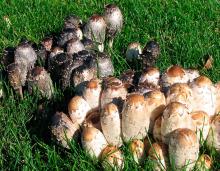
Species Types
Scientific Name
Coprinus comatus
Description
The shaggy mane has a white, shaggy, cylindrical cap that turns black and inky. It often grows in large numbers along roadsides and in lawns and disturbed areas.
Media
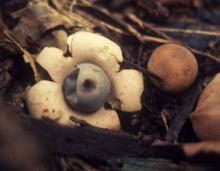
Species Types
Scientific Name
Geastrum species
Description
An earthstar is a roundish ball in the center of starlike rays. It grows on the ground in open woods.
Media

Species Types
Scientific Name
Lycoperdon perlatum
Description
The gem-studded puffball is a white, rounded to turban-shaped ball, densely covered with spiny warts, developing a pore at the top. It grows on the ground in open woods, along roads, in waste areas.
Media
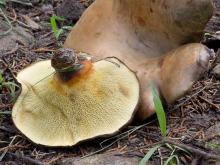
Species Types
Scientific Name
Boletinellus merulioides
Description
The ash tree bolete is a pored mushroom with a brownish, wavy cap, an off-center stalk, and clearly defined pores. It grows scattered on the ground near ash trees.
Media
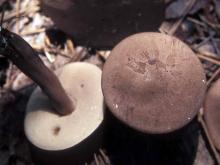
Species Types
Scientific Name
Tylopilus plumbeoviolaceus
Description
The violet-gray bolete has a large, violet-gray cap with cream-pink pores, and a violet stalk that is sometimes webbed. It grows scattered on the ground in mixed woods.
Media
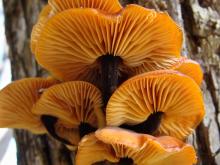
Species Types
Scientific Name
Flammulina velutipes
Description
The velvet foot, or enoki, has a tawny, sticky cap with whitish gills. The stalk is yellowish above and brownish below. They grow in clusters on deciduous logs.
Media

Species Types
Scientific Name
Grifola frondosa
Description
Looking like a ruffled chicken, the edible hen of the woods mushroom grows like large circular bouquet of spoon-shaped caps, each grayish brown on top and white beneath, emerging from a branching, whitish base. It grows on the ground at the base of oak trees.
Media

Species Types
Scientific Name
Meripilus sumstinei (formerly M. giganteus)
Description
The black-staining polypore grows in large, circular clusters of many fleshy, grayish yellow, fan-shaped caps, which bruise black when cut or touched. It grows on the ground around deciduous trees, especially oaks.
See Also



Media

Species Types
Scientific Name
Monotropa hypopitys
Description
Pinesap is a plant that puts the "wild" in wildflower! It lacks chlorophyll, so its roots connect to fungi underground and absorb nutrients from the fungi.
Media

Species Types
Scientific Name
Cladophora, Pithophora, and Spirogyra spp., and others
Description
Filamentous green algae forms green, cottony masses that are free-floating or attached to rocks, debris, or other plants.
Media

Species Types
Scientific Name
Monotropa uniflora
Description
Indian pipe lacks chlorophyll, so it is white, not green. Below ground, its roots join with fungi that connect to tree roots. This plant, then, takes nourishment indirectly from the trees.
About Mushrooms in Missouri
Mushrooms are a lot like plants, but they lack chlorophyll and have to take nutrients from other materials. Mushrooms are neither plants nor animals. They are in a different kingdom — the fungi. Fungi include the familiar mushroom-forming species, plus the yeasts, molds, smuts, and rusts.
Always be cautious when eating edible mushrooms. Be absolutely sure of the ID, and only eat a small amount the first time you try it to avoid a reaction..





















